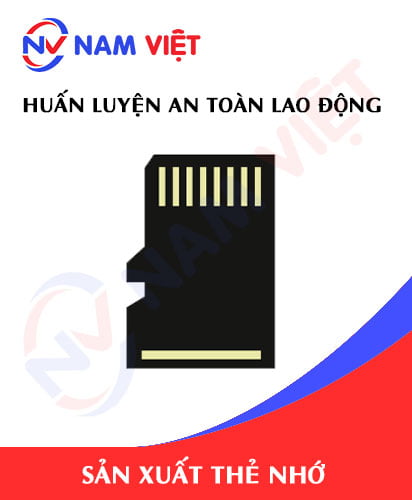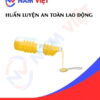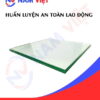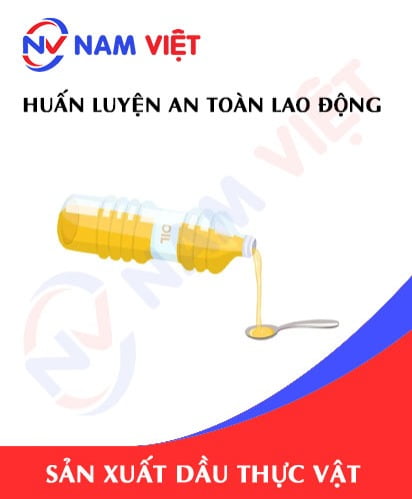Occupational Safety Training for Memory Card Manufacturing
99,000 ₫
Note: The above price is calculated for one person, the price may fluctuate depending on the number of trainees attending the course and market movements. For more accurate pricing support, please refer to the price list or contact our consulting staff directly.
Occupational safety is an important issue in factory manufacturing memory cards and needs to be addressed promptly to ensure the health and safety of workers, as well as enhance the reputation of businesses. The Occupational Safety Training course is one of the effective solutions to raise awareness of how to prevent workplace accidents for employees participating in memory card manufacturing.
Table of Contents
Toggle1. Overview of Memory Cards
a. What is a Memory Card?
- A memory card is a card-shaped data storage device used to store, transfer, and record files or data on electronic devices such as computers, mobile phones, digital cameras, camcorders, music players, game consoles, and other electronic devices. Memory cards come in various types and sizes, including Secure Digital (SD), microSD, CompactFlash (CF), Memory Stick, and XD-Picture Card. Memory cards are usually designed to be compact, convenient, and easily removable and insertable into devices.
- The memory card manufacturing industry in Viet Nam has been developing rapidly in recent years. Many domestic and foreign enterprises have invested in manufacturing memory cards and related products such as USB drives, portable hard drives, SSD memory cards, microSD cards, etc.
- According to the report of the General Statistics Office of Viet Nam, in 2020, memory card output in Viet Nam reached approximately 241 million units, an increase of 12.6% compared to 2019. At the same time, production value also increased by up to 21.8% compared to the previous year.
- Memory card manufacturing in Viet Nam is gradually becoming one of the sectors attracting attention from domestic and foreign investors, especially in recent years as the Viet Nam government focuses on developing the supporting industry.

b. Machinery for Memory Card Manufacturing
Memory card manufacturing machinery typically includes:
- Memory card stamping machine: This machine is used to cut and shape memory cards, capable of producing memory cards of different sizes and designs.
- Glue dispensing machine: This machine is used to apply glue to memory card components to ensure adhesion during assembly.
- Printing machine: The printer is used to print information on the memory card, including names, logos, images, or barcodes.
- IC pin soldering machine: This machine is used to solder IC pins onto the memory card surface.
- Inspection machine: The inspection machine is used to check the quality of memory cards after production.

c. Typical Memory Card Manufacturing Companies
Currently, there are many companies manufacturing and trading memory cards in Viet Nam. Below are some typical enterprises in the memory card manufacturing sector in Viet Nam:
- Samsung: One of the leading companies in Viet Nam and worldwide manufacturing memory cards. Samsung produces various types of memory cards, including microSD, SD, Compact Flash, MMC, etc.
- Toshiba: A Japanese company with headquarters in Viet Nam. Toshiba manufactures different types of memory cards, including SD, microSD, Compact Flash, etc.
- SanDisk: An American technology company, acquired by Western Digital. SanDisk produces memory cards such as microSD, SD, Compact Flash, USB drives, etc.
- Kingston: An American company operating in Viet Nam. Kingston produces memory cards such as SD, microSD, Compact Flash, USB drives, etc.
- Transcend: A company from Taiwan operating in Viet Nam. Transcend manufactures memory cards such as SD, microSD, Compact Flash, MMC, Memory Stick, etc.
d. Specific Jobs in a Memory Card Manufacturing Factory
Group 1
- CEO, deputy CEO, department heads in a memory card manufacturing factory.
Group 2
- Safety officer: Manages safety in the factory, designs safety procedures, supervises and ensures employees comply with safe working procedures.
Group 3
- Equipment assembly: Assemble components and modules onto circuit boards to create memory card storage devices.
- Quality inspection: After assembly, products are checked to ensure all functions work correctly.
- Product packaging: After quality inspection, products are packaged and prepared for shipment.
- Quality management: Memory card factories must have quality management systems to ensure products meet quality and safety standards.
- Equipment maintenance: Factory staff must regularly maintain and repair equipment to ensure production efficiency.
- Warehouse management: Produced memory cards are stored in the warehouse before distribution to agents and retail stores. Warehouse management is essential to ensure products are properly stored and preserved.
Group 4
- Office work, service, sales, marketing.
- Production management, quality management, human resource management, material management, financial and accounting management.
- Research and development of new products, designing product packaging and samples.

2. Overview of Memory Card Manufacturing Safety Training Course
In this article, we focus on issues surrounding Group 3, because Group 3 is directly involved in the manufacturing process and bears the highest occupational safety risks. Refer to other groups here.
a. What is Group 3 Occupational Safety Training?
- Group 3 Occupational Safety Training are sessions that equip workers with knowledge on preventing workplace accidents.
- The occupational safety training course helps workers recognize and prevent hazards, reducing risks of workplace accidents while working.
REGISTER FOR OCCUPATIONAL SAFETY TRAINING SERVICE
b. Training Duration
Initial safety training duration
- Total training time is at least 24 hours, including examination time.
- 8 hours of theoretical study on policies and laws regarding occupational safety and hygiene
- 8 hours of theoretical study on basic occupational safety and hygiene knowledge
- 4 hours of theoretical study on specialized training content
- 2 hours of practical study on specialized training content
- 2 hours of theoretical examination at the end of the course
The safety training center will schedule sessions according to employee availability. Typically, there are 6 training sessions over 3 days, provided the factory arranges continuous training time.
Periodic safety training duration
- Before the occupational safety card expires, workers who wish to renew must undergo periodic occupational safety training, with periodic training duration being at least 50% of the initial training duration.
Explanation: The total duration of periodic occupational safety training is at least 12 hours, including examination time. Upon completing the course and passing the test, the worker will be reissued or have the occupational safety card extended.
c. Training Content
| No. | TRAINING CONTENT | TRAINING DURATION (HOURS) | |||
| Total | Including | ||||
| Theory | Practice | Examination | |||
| I | System of policies and laws on occupational safety and hygiene | 8 | 8 | 0 | 0 |
| 1 | Overview of legal documents system on occupational safety and hygiene. | 6 | 6 | ||
| 2 | System of standards and technical regulations on occupational safety and hygiene. | 1 | 1 | ||
| 3 | Specific regulations of state management agencies on occupational safety and hygiene when building, expanding, or renovating works and facilities for manufacturing, using, storing, and inspecting machines, equipment, materials, and substances with strict safety and hygiene requirements. | 1 | 1 | ||
| II | Basic knowledge of occupational safety and hygiene | 8 | 8 | 0 | 0 |
| 1 | Basic knowledge about hazardous and harmful factors in the workplace. | 4 | 4 | ||
| 2 | Methods to improve working conditions. | 1 | 1 | ||
| 3 | Safety culture in production and business. | 1 | 1 | ||
| 4 | Rights and obligations of employers and workers; policies on occupational safety and hygiene for employees; roles and duties of safety and hygiene staff. | 1 | 1 | ||
| 5 | Rules on occupational safety and hygiene, signs, safety guidance, usage of safety equipment, personal protective equipment; skills for first aid in workplace accidents, and occupational disease prevention. | 1 | 1 | ||
| III | Specialized training content | 6 | 4 | 2 | 0 |
| Comprehensive knowledge about machines, equipment, and substances causing hazardous and harmful factors; analysis, evaluation, risk management on occupational safety and hygiene; safe working procedures with machines, equipment, and substances with strict safety and hygiene requirements. | 6 | 4 | 2 | ||
| IV | Final examination on occupational safety training | 2 | 2 | 0 | 0 |
| Total | 24 | 22 | 2 | ||
See more training content of 6 groups
d. Occupational Safety Card
After completing the occupational safety training course and passing the examination, workers will be issued an occupational safety card (commonly known as Group 3 safety certificate).
The Group 3 safety card clearly displays information such as full name, date of birth, specific job, and work environment. It also shows training duration, red stamp, and signature confirming course completion.
According to the card issuance regulations in Clause 2 of Article 24, Decree 44/2016/ND-CP, there are two cases:
- If the employer and worker have a labor contract, the employer must sign, stamp, and validate the occupational safety card for Group 3 trainees after completing the course and passing the test from the occupational safety training unit.
- If the worker is freelance or seasonal and does not have a labor contract, the training unit must sign, stamp, and validate the occupational safety card after the worker completes the course and passes the test.

3. Recognizing Hazards in Memory Card Manufacturing
Some potential hazards affecting workers’ health and safety during memory card manufacturing may include:
- Memory card manufacturing often involves the use of chemicals and fine powders during production. These dust and fine particles can remain suspended in the air and be inhaled into the lungs, causing respiratory issues, pneumonia, or prostate disease.
- Memory card manufacturing often requires machines to operate continuously for long periods, which can generate high temperatures and intense light. Workers may suffer skin and eye damage if they do not wear adequate protective equipment such as helmets, safety goggles, and protective clothing.
- The use of chemicals, toxic gases, and lubricants in memory card manufacturing may create fire and explosion risks. Workers need fire prevention and firefighting training, and safety measures should be implemented to minimize these risks.
- Accidents such as collisions, burns, cuts, or crushing may occur during memory card manufacturing if safety measures are not followed and protective equipment is not properly used.
4. Common Occupational Accidents in Memory Card Manufacturing
Common occupational accidents during memory card manufacturing may include:
- Electrical accidents: Production processes in memory card manufacturing use many electrical devices, from machinery to small tools like cutters and scissors. Therefore, the risk of electric shock or short circuits is very high.
- Material-related injuries: During production, parts of machinery and various materials are used to create memory cards. These may fly off and injure factory employees.
- Chemical hazards: Chemicals used to produce memory card components can be harmful to health if not handled properly.
- Machinery malfunctions: Parts of machinery may break or degrade during use. If not repaired or replaced promptly, they may cause accidents for workers.
- Failure to use protective equipment: To protect employees’ health, memory card manufacturing factories need to provide adequate protective equipment such as safety goggles, gloves, masks, etc. If not used properly, accidents may occur.

5. Safety Measures When Participating in Memory Card Manufacturing
To ensure worker safety during memory card manufacturing, the following safety measures should be implemented:
- Ensure hygiene in the factory: Use sanitation methods to keep the workplace clean, ensure worker safety, and prevent contamination.
- Ensure electrical safety: Conduct regular inspections, maintenance, and use electrical protection devices to ensure safety in environments with many electronic devices.
- Training and provision of protective equipment: Workers should be trained on production procedures, machine operation, and protective equipment such as helmets, safety goggles, gloves, and protective shoes to ensure safety during work.
- Use safety equipment: Use explosion-proof devices, fire alarm systems, sprinkler systems, and rescue safety systems to ensure safety in all situations.
- Control temperature and humidity: Control temperature and humidity to ensure optimal working conditions for workers and proper storage of electronic components, preventing accidents during production.
- Quality inspection: Check the quality of components, materials, and finished products to ensure product quality and prevent accidents due to defective products.
- Ensure transportation safety: Transport products according to proper procedures, using full protective measures to ensure the safety of transport personnel and avoid accidents during transport.
- Periodically conduct occupational environment monitoring in factories, collect and analyze harmful factors for workers, and adjust to reduce hazards to prevent occupational diseases.
6. Benefits of Occupational Safety Training in Memory Card Manufacturing
An Toan Nam Viet provides enterprises with the following benefits after completing occupational safety training courses according to Decree 44/2016/ND – CP on Occupational Safety and Hygiene:
- Workers can recognize potential risks of occupational accidents and take preventive measures to avoid them.
- Enterprises can establish risk prevention measures in production, operation, and maintenance processes.
- Reduce costs associated with potential safety incidents.
- Uninterrupted production increases labor productivity and product quality.
- Compliance with occupational safety laws, avoiding legal risks.
- Enhance corporate reputation and professionalism, elevating the enterprise’s brand.
Nam Viet’s training courses are a solution to prevent external hazards, helping individuals avoid dangers that could lead to injury or even death.
REGISTER FOR OCCUPATIONAL SAFETY TRAINING SERVICE
7. Customer Feedback After Completing Memory Card Safety Training
An Toan Nam Viet has many years of experience accompanying enterprises in Vietnam, especially in the southern provinces. This responsibility is invaluable to Nam Viet, which is why its occupational safety training has been increasingly professional. The motivation for An Toan Nam Viet’s growth comes from both positive feedback and suggestions from enterprises. Below are the feedbacks from partners we have served.
Bac Nam E&C Investment and Construction Joint Stock Company
“The first time using An Toan Nam Viet’s service, I was surprised by the 24/7 support from the consulting team. Class organization was fast and convenient for our company. Thank you very much for Nam Viet’s service!”
See more customer interview sessions after using An Toan Nam Viet services
8. An Toan Nam Viet’s Occupational Safety Training Capacity
An Toan Nam Viet is a reputable and quality occupational safety training center in Vietnam, conducting continuous training at factories, workshops, and construction sites across all 63 provinces in Vietnam.
REGISTER FOR OCCUPATIONAL SAFETY TRAINING SERVICE
Occupational Safety Training License
- An Toan Nam Viet has been inspected and certified by the Department of Occupational Safety under the Ministry of Labor, War Invalids and Social Affairs, issuing certificates of eligibility for occupational safety and hygiene training, strengthening our occupational training capacity.

Training Materials and Lectures
- Before occupational safety training materials are included in safety training courses, they are reviewed to ensure accurate knowledge and effective application.
- Teaching methods of instructors are standardized according to An Toan Nam Viet guidelines, developed by experts in occupational safety and hygiene training for maximum learning efficiency.
Facilities
- Control of classroom factors affecting training enhances teaching efficiency and knowledge absorption.
- Our training facilities provide spacious classrooms meeting standards for area, lighting, and training equipment.
9. Nationwide Reputable Safety Training Center
At An Toan Nam Viet, we prioritize professional occupational safety training. For us, teaching workers self-protection knowledge contributes to national development.
To ensure effective training, we meticulously prepare every detail, from teaching tools, equipment, curriculum, materials, sound, and lighting.
Our occupational safety instructors are experts with many years of experience, including research on hazards across industries and prevention methods.
Lectures are practical, vivid, and easy to understand for workers, facilitating comfortable learning while aligning with Decree 44/2016/ND-CP.
Workers learn many hazard prevention measures and how to protect themselves, applying them appropriately in real work situations.
Our training center is proud to provide professional, reputable occupational safety training with the following advantages:
- Competitive training costs while maintaining quality.
- Flexible training schedules accommodating enterprise production.
- Fast certification procedures compliant with the law.
- Experienced instructors with long-term expertise.
- Classrooms controlled to enhance teaching efficiency and knowledge absorption.
- Lectures designed to suit occupational safety needs in enterprises.
- An Toan Nam Viet works dedicatedly and professionally to support customers accurately and promptly.

10. Additional References for Memory Card Occupational Safety Training
- Memory Card Occupational Safety Documents (Memory Stick)
- Occupational Safety Training Material Set
- Occupational Safety Training Test Set
- Memory Card Occupational Safety Quiz (Memory Stick)
- Memory Card Occupational Safety Training Slides (Memory Stick)
1 review for Occupational Safety Training for Memory Card Manufacturing
No comments yet















namchinh.haiphong341
Dịch vụ huấn luyện an toàn lao động rất tốt nhé, giảng viên dạy rất sinh động dễ hiểu!